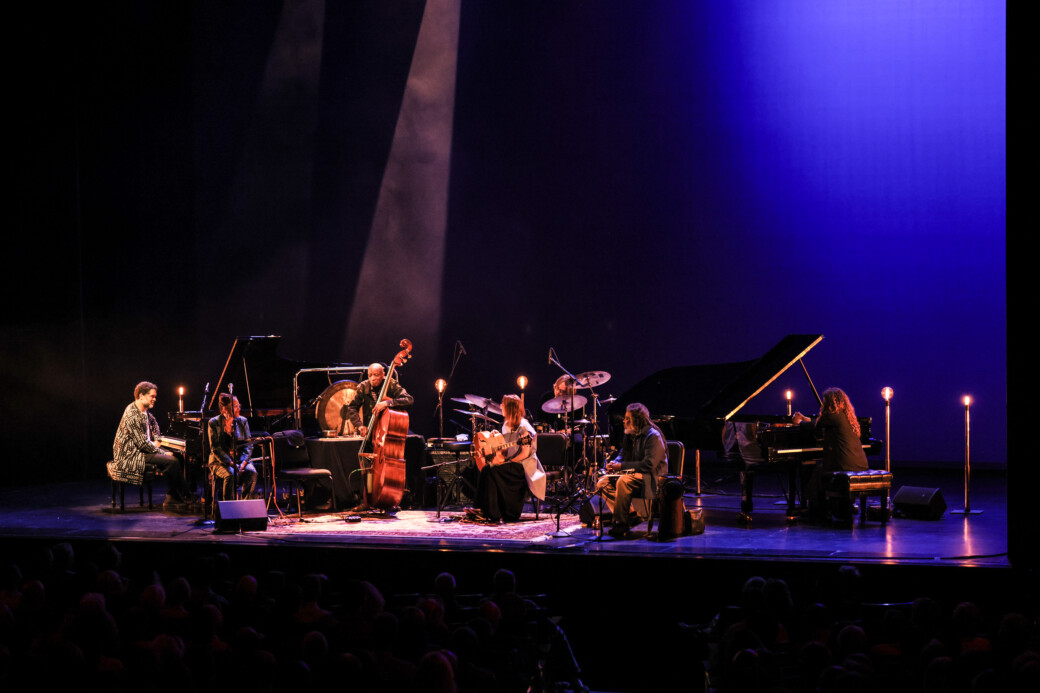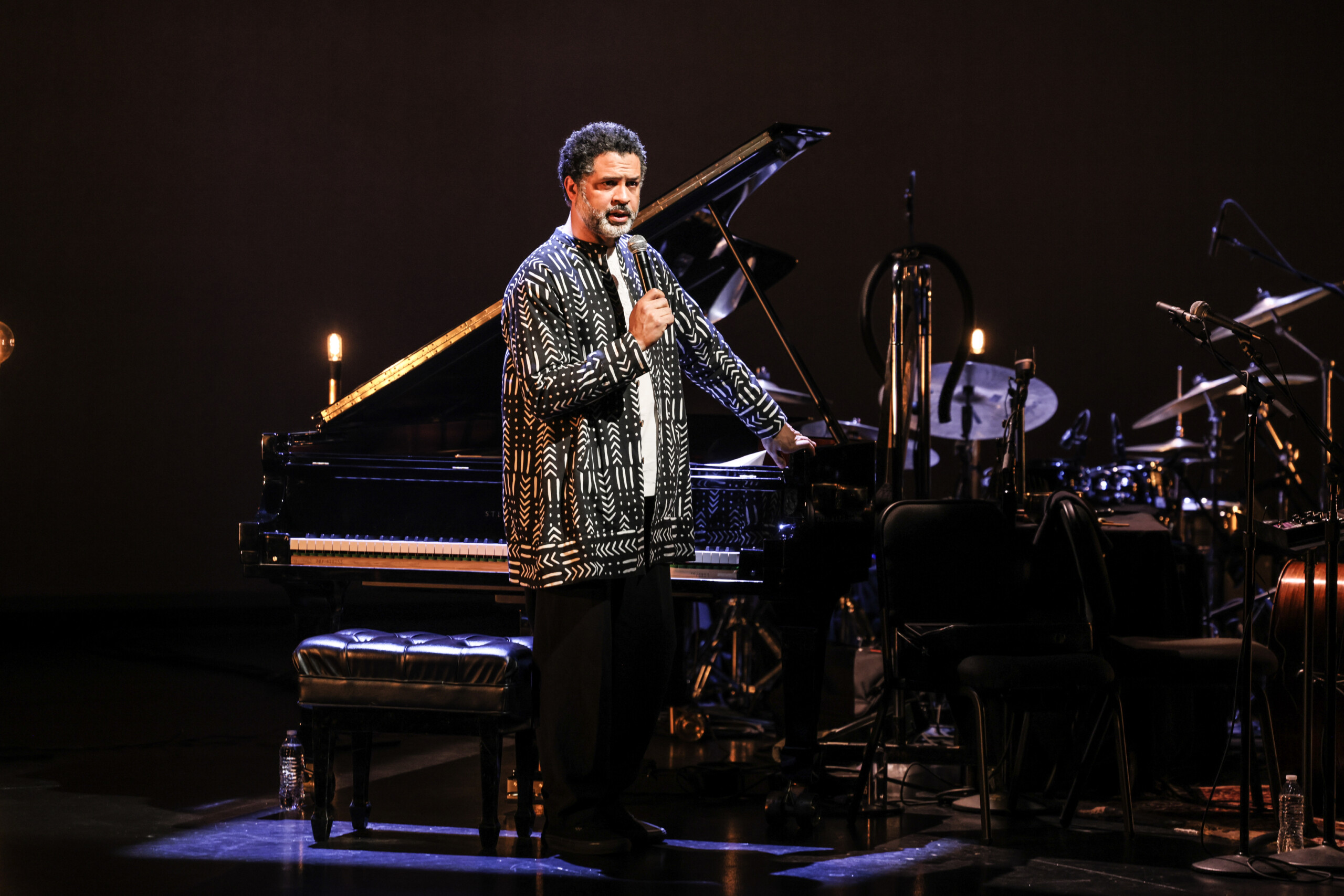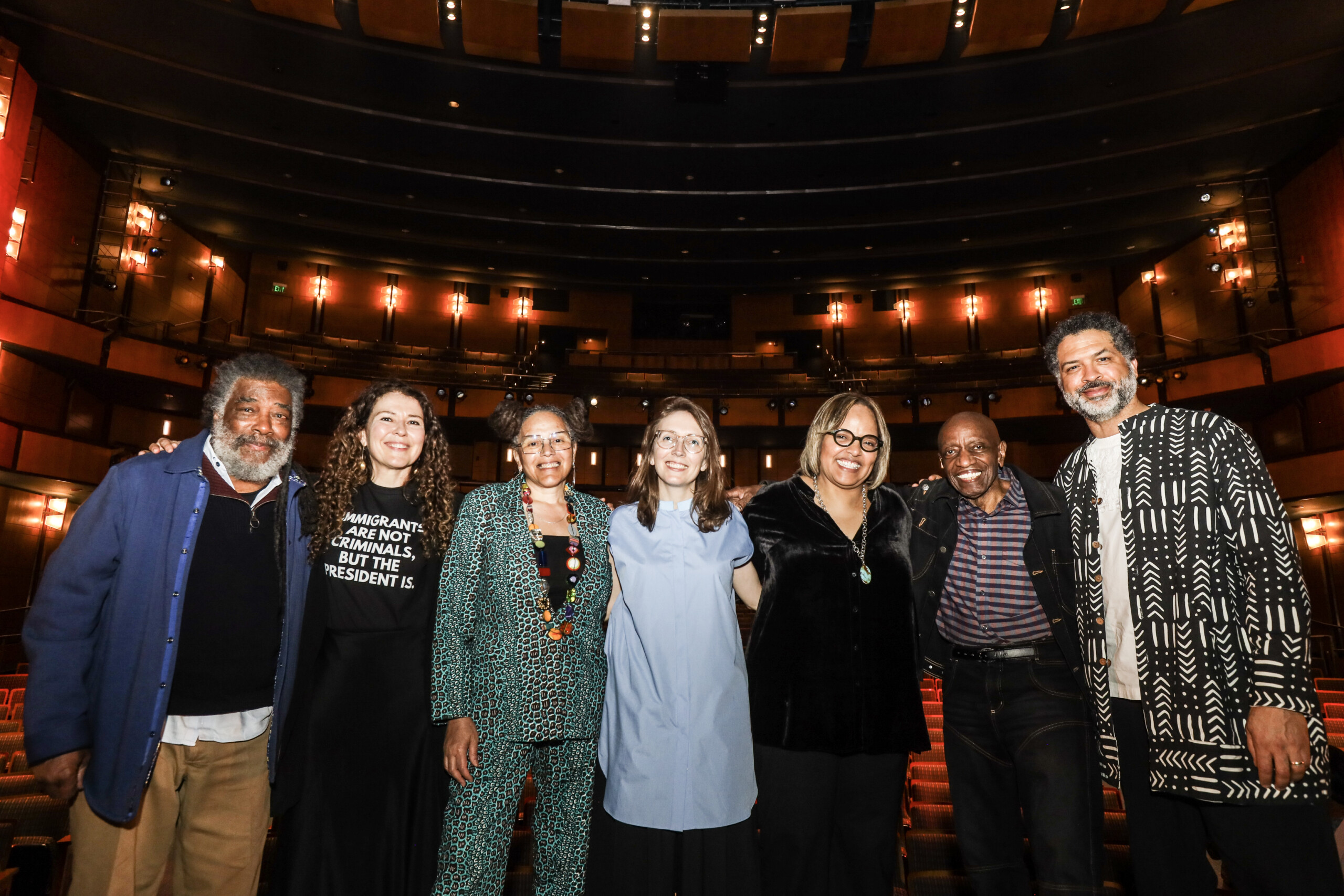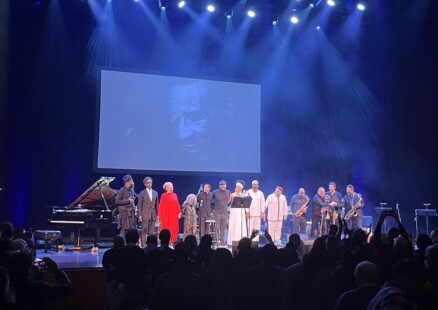At the Kennedy Center, Jason Moran and friends meditate on the arts of making – and listening

Jason Moran & Friends
Kennedy Center – Eisenhower Theater
Thursday, April 24, 2025
“Give me three notes.”
This is the challenge pianist Jason Moran issued to the crowd at the Kennedy Center’s Eisenhower Theater shortly after he walked on stage. The comment here, as it did then, needs context. Moran said this same question was posed by his predecessor, Dr. Billy Taylor, when the pianist visited Moran’s Houston high school. “He sat down and he just made,” Moran recalled.
“Tonight,” Moran told us “is about making.”
And so, Moran did, building an improvised piece using only F sharp, B flat and C – someone also gave Moran a chuckle by calling out “A minor” – that began slowly like a lethargic stroll, eventually building into a heavy rainstorm of notes as his fingers rapidly pounded the keys.
From there, Moran did not stop making for over an hour, as the stage filled up one-by-one with fellow maestros, from guitarist Mary Halvorson – the youngin’ of the ensemble at age 44 – to the 87-year-old bass doyen Reggie Workman. And despite organizing an ensemble that featured such towering composers of pre-arranged music as Nicole Mitchell, Terri Lyne Carrington and Wadada Leo Smith, the performance truly was devoted to making, as each of the night’s eight pieces was composed in real time. Just another exercise in imagination for jazz’s great conceptualist.

First out was fellow pianist Sylvie Courvoisier, wearing a t-shirt that read “immigrants are not criminals, but the president is.” With each piano bookending the bandstand, the two ivories players established an early group framework for the compositions to unfold. Moran played somewhere between Jaki Byard and Anthony Davis – ruminative and harmonically progressive – while Courvoisier embodied the dynamics and instrumental imagination of John Cage and Andrew Cyrille. She would often ruffle the piano keys before leaping up to pluck and bang the piano’s strings, doing her best to turn the percussive harmonic instrument into a string instrument of texture and melody.
Wadada Leo Smith came onstage next to the kind of whooping applause – Courvoisier received similar – this writer expected more from an audience at Rhizome than the more rarified airs of the Kennedy Center. Perhaps it was a sign of just how much those in attendance needed to hear the piercing, shocking honesty of Smith’s horn, sounding with awe and comfort like Gabriel appearing to Zechariah. While the prior piano duo was a constant back and forth, Smith took Miles Davis-like pauses to let the pianists build under him.
When Halvorson took the stage for the next piece, Smith’s silence deepened. While Halvorson dialed in effects, stretching a two-chord pattern with delays so long it felt more like a loop pedal, Smith sat in reverential silence: his eyes closed, hands folded together as if in prayer or meditation, trumpet laying flat across his lap. Here is where a main theme of the night emerged. While yes, these series of performances were a masterclass in technique, composition, tone and the like, they were also a lesson in that most important skill to the jazz musician and audience: listening.
This became easier to see as the seven musicians filtered onstage, when the septet would coalesce and then break out into spontaneous smaller combos. Near the end, Moran began playing an ominous, marching melody that Halvorson complemented and counterpoint with riffs and motifs plucked across the fretboard. Or when Nicole Mitchell walked onstage following Halvorson and began playing the flute, conjuring a musical history that ranged from the Andes to Chicago, from Mozart to Herbie Mann. This was accompanied by more meditative listening from Smith and Halvorson, as Courvoisier joined in to punctuate Mitchell’s monologue with riffs of texture.

By the time Terri Lyne Carrington took the stage, it was clear who would begin each piece: the musician who had just walked onstage. For Carrington’s turn to set the pace, she utilized that Cyrille sense of playing the whole kit, rattling the rims and sides of drums and the edges of cymbals in some ancient-feeling invocation.
From there on, who led the music became a mystery. Through work of the six musicians onstage the spontaneous concerto grew deeper, wider, taller and fuller as they took turns to build on what ideas their fellows presented – Carrington with the kit booming like timpanis, Smith’s horn howling as a voice crying out in the desert and the two pianists conjuring twisters of notes.
Finally, Workman – the elder of this group, representing 60-plus years and several generations of Great Black Music – took the stage and completed the ensemble in the penultimate piece.
Here, the arts of making and listening crystalized.
At this point, different sections of the ensemble would drop out at a time to let others build and develop their ideas. With Workman on bass – and then on “little instruments” and the Tibetan prayer bowl – Carrington and Halvorson would often work texturally as opposed to rhythmically or melodically, building “the sound” of the piece. Meanwhile, the rest would build harmony and melody until Moran too finally sat back and took his hands off the keys for the first time during the night.
Was anyone soloing, that striking feature of jazz since the swing era? No. But the constant turns of joining in the composition in real time, listening to the other musicians onstage to figure out how to build and improve the music, reminded me of something Wayne Shorter told this publication: “Learning how to improvise, to negotiate and deal with the unexpected, and have our egos serve us instead of us serving our egos – that’s why jazz musicians take solos. It’s an attempt to demonstrate equality in a constant way.”
It was striking for the seven musicians onstage to have this kind of demonstration of trust, equality and a pure showcase of American democratic ideals in the Eisenhower Theater, named for the president who first sent jazz musicians out into the world to dispel Soviet accusations of virulent racism in the “land of the free” (however accurate those accusations were). It was all the more striking because the theater’s current ultimate supervisor, President and Kennedy Center chairman Donald Trump, is pursuing an agenda that seems at odds with the values Ike sought to inspire abroad.
That atmosphere, while never addressed onstage, seemed to also inform Moran’s choices for the night: to center the evening about making. We in D.C. and beyond see headlines about the president reducing things: federal spending; commitment of military aid to allies; of foreign aid and assistance to those who need it in far-flung places; the number of federal workers. In a city where it seems like reduction and destruction are around every turn, the act of simply making – of creating – felt all the more quietly radical.




